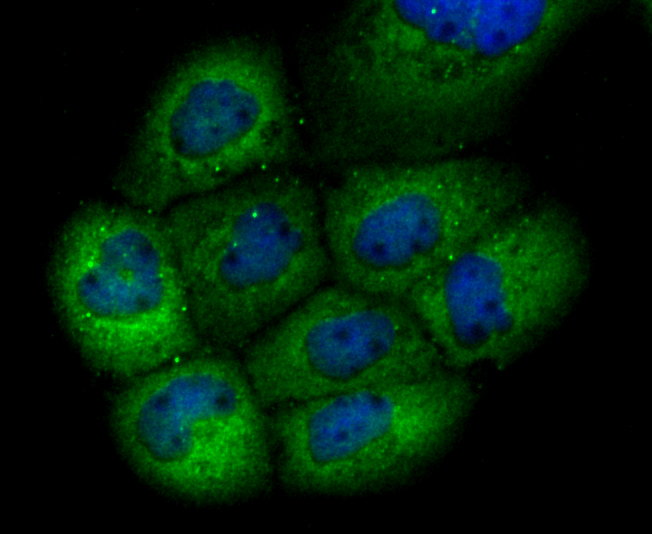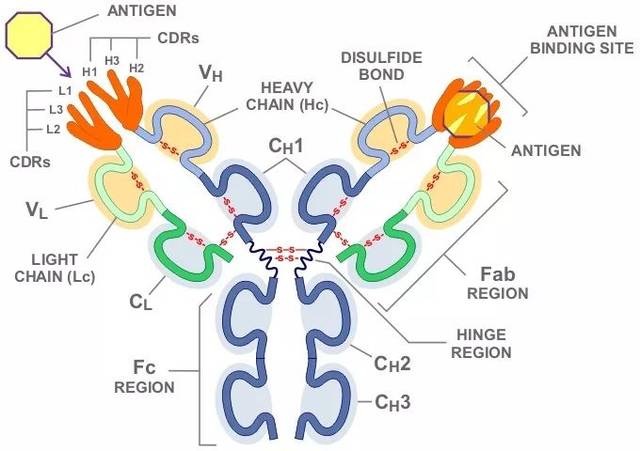Product Name :
GCLM polyclonal antibody Background :
Gamma-glutamylcysteine synthetase (γ-GCS) is the rate limiting enzyme for glutathione (L-gamma-glutamyl-L-cysteinylglycine, GSH) synthesis. GSH is ubiquitous in mammalian cells as a vital intra- and extracellular protective antioxidant. γ-GCS is a heterodimer of a heavy catalytic subunit and a light regulatory subunit that is responsive to inflammation, phenolic antioxidants, heat shock, oxidants and cytokines. The human gamma-GCS gene encoding the 367 amino acid catalytic subunit maps to chromosome 6p12. The human γ-GCS gene encoding the regulatory subunit maps to chromosome 1p22-p21. The two subunits of γ-GCS form a heterodimeric zinc metalloprotein that gains activity through formation of a reversible disulfide bond. Product :
Rabbit IgG, 1mg/ml in PBS with 0.02% sodium azide, 50% glycerol, pH7.2 Storage&Stability :
Store at +4°C after thawing. Aliquot store at -20°C or -80°C. Avoid repeated freeze / thaw cycles. Specificity :
GCLM polyclonal antibody detects endogenous levels of GCLM protein. Immunogen :
Recombinant protein Conjugate :
Unconjugated Modification :
Unmodification
GCLM polyclonal antibody Background :
Gamma-glutamylcysteine synthetase (γ-GCS) is the rate limiting enzyme for glutathione (L-gamma-glutamyl-L-cysteinylglycine, GSH) synthesis. GSH is ubiquitous in mammalian cells as a vital intra- and extracellular protective antioxidant. γ-GCS is a heterodimer of a heavy catalytic subunit and a light regulatory subunit that is responsive to inflammation, phenolic antioxidants, heat shock, oxidants and cytokines. The human gamma-GCS gene encoding the 367 amino acid catalytic subunit maps to chromosome 6p12. The human γ-GCS gene encoding the regulatory subunit maps to chromosome 1p22-p21. The two subunits of γ-GCS form a heterodimeric zinc metalloprotein that gains activity through formation of a reversible disulfide bond. Product :
Rabbit IgG, 1mg/ml in PBS with 0.02% sodium azide, 50% glycerol, pH7.2 Storage&Stability :
Store at +4°C after thawing. Aliquot store at -20°C or -80°C. Avoid repeated freeze / thaw cycles. Specificity :
GCLM polyclonal antibody detects endogenous levels of GCLM protein. Immunogen :
Recombinant protein Conjugate :
Unconjugated Modification :
Unmodification
-
 Western blot analysis of GCLM on different cell lysates using anti-GCLM antibody at 1/500 dilution. Positive control: Lane 1: A431 Lane 2: PC-12 Lane 3: NIH-3T3
Western blot analysis of GCLM on different cell lysates using anti-GCLM antibody at 1/500 dilution. Positive control: Lane 1: A431 Lane 2: PC-12 Lane 3: NIH-3T3 -
 ICC staining GCLM in A431 cells (green). The nuclear counter stain is DAPI (blue). Cells were fixed in paraformaldehyde, permeabilised with 0.25% Triton X100/PBS.
ICC staining GCLM in A431 cells (green). The nuclear counter stain is DAPI (blue). Cells were fixed in paraformaldehyde, permeabilised with 0.25% Triton X100/PBS.
DT-13 Ameliorates TNF-α-Induced Vascular Endothelial Hyperpermeability via Non-Muscle Myosin IIA and the Src/PI3K/Akt Signaling Pathway
PMCID: Pubmed No.:28855900
Ginseng root extract attenuates inflammation by inhibiting the MAPK/NF-κB signaling pathway and activating autophagy and p62-Nrf2-Keap1 signaling in vitro and in vivo
PMCID: Pubmed No.:34648903
Bioworld Biotech only provide peptides for our antibodies and do not provide additional peptide customization services.
Price/Size :
USD 368/1mg/vial
Tips:
For phospho antibody, we provide phospho peptide(0.5mg) and non-phospho peptide(0.5mg).Describe :
Blocking peptides are peptides that bind specifically to the target antibody and block antibody binding. These peptide usually contains the epitope recognized by the antibody. Antibodies bound to the blocking peptide no longer bind to the epitope on the target protein. This mechanism is useful when non-specific binding is an issue, for example, in Western blotting (WB) and Immunohistochemistry (IHC). By comparing the staining from the blocked antibody versus the antibody alone, one can see which staining is specific; Specific binding will be absent from the western blot or IHC performed with the neutralized antibody.Formula:
Synthetic peptide was lyophilized with 100% acetonitrile and is supplied as a powder. Reconstitute with 0.1 ml DI water for a final concentration of 10 mg/ml.The purity is >90%,tested by HPLC and MS.
Storage:
The freeze-dried powder is more stable. For short time at 2-8°C. For long term storage store at -20°C.
Note :
This product is for research use only (RUO only). Not for use in diagnostic or therapeutic procedures.
 GCLM polyclonal antibody
GCLM polyclonal antibody  Datasheet
Datasheet COA
COA MSDS
MSDS SHIP
SHIP